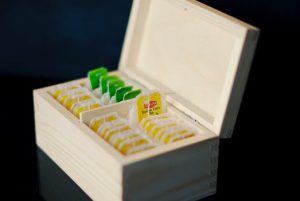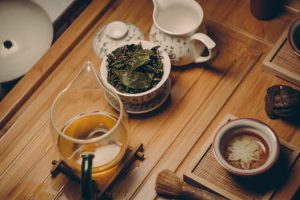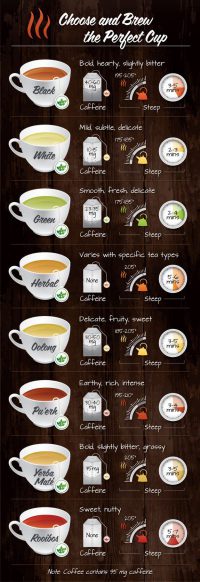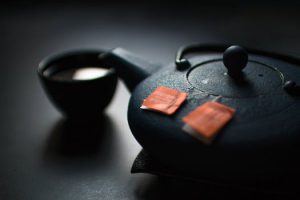Theoretically, it is easy to brew tea. I learned how to make it by watching my  mom when I was about 10 years old. Honestly, it wasn’t rocket science and only included about three to five steps:
mom when I was about 10 years old. Honestly, it wasn’t rocket science and only included about three to five steps:
- Boil water
- Place tea bag into mug
- Pour hot water over tea bag
Opitional
- Sweeten
- Enjoy!
Pretty simple stuff. At least that’s what I thought until I started exploring teas.
All teas aren’t created equal
 I’m no tea prude. In fact, until my adult years, Lipton was my absolute favorite tea. I have nothing against Lipton now, however, I’ve discovered there’s a whole world of tea out there. From loose leaf to bagged, Herbal to Pu-erh, there are far more teas than I ever imagined as a kid. Just the basic teas themselves is a big subject. Add to that the number of blends available, and we have a subject that could go on for millennia! But let’s not get too anxious here.
I’m no tea prude. In fact, until my adult years, Lipton was my absolute favorite tea. I have nothing against Lipton now, however, I’ve discovered there’s a whole world of tea out there. From loose leaf to bagged, Herbal to Pu-erh, there are far more teas than I ever imagined as a kid. Just the basic teas themselves is a big subject. Add to that the number of blends available, and we have a subject that could go on for millennia! But let’s not get too anxious here.
There’s only one thing that matters when selecting a good tea: quality.
Like I said, I am not a prude. However, quality is a valid concern in anything. A prime example of this is my experience with Green Tea. It wasn’t until I found a Green Tea blend made with a quality leaf that I realized A.) Green Tea doesn’t have to kill my stomach and B.) it can actually taste really good.
So how do you select a qualiTea (sorry couldn’t help myself) tea? It’s simpler than you think.
Selecting Quality Leaves
There are a few simple steps to selecting quality tea leaves, so that you can  make the perfect brew. It doesn’t require any fancy equipment or knowledge either. All you need are your senses, and you’ll be off to making a quality cup of tea in no time.
make the perfect brew. It doesn’t require any fancy equipment or knowledge either. All you need are your senses, and you’ll be off to making a quality cup of tea in no time.
Step 1 – See thy leaf:
You may have never thought about it, but the way tea leaves look can greatly affect its taste. I never even considered what tea leaves looked like until purchasing loose leaf tea. I assumed whatever was in the bag was just fine. Wrong. Now, I’m not saying you need to start going an tearing open all of your tea bags or mulling over your loose leaf tea with a magnifying glass. However if you notice that either
- there’s a bit of debris after brewing with bags
or
- there are leaves of varying sizes, tea dust, or stems in your loose leaf blend
then, the quality of your tea is poor. Of course at the end of any container of loose-leaf you’re going to see a little debris. However, as a whole your tea leaves should be whole, uniform, contain no stems (unless purposefully purchasing broken leaf), and contain no tea dust. These bits will stand in the way of a good, consistent tasting brew.
Step 2 – Sniff thy leaf:
 As a kid, I used to hate when my cousin would sniff his food before he ate it. Turns out he may have been on to something.
As a kid, I used to hate when my cousin would sniff his food before he ate it. Turns out he may have been on to something.
Smelling your dry tea before brewing is rather important. Why? Because it should smell like that tea should after you brew it. For example: a high quality Jasmine Tea should smell like sweetly scented flowers, nutmeg, and an earthiness that you’d associate with Black Tea.
Step 3 – Taste thy leaf
This may sound odd, but the taste of the tea leaves is also important. There are few occasions in which I’ve had the opportunity to taste a leaf before purchasing. It can be very useful, though not absolutely necessary before purchasing your tea. Rather, this is more of an exercise you could use at home to see if your tea is still fresh, or to discern if what you bought was of quality. We don’t want folks in your local grocery store looking at you like you’re crazy. I get enough stares smelling the fruits in the produce section, and wouldn’t wish that awkward tension on anyone.
This step is very similar to the last. Your dry leaves should taste characteristic of the tea itself. For example: a high quality Longjing or Dragon Well Tea should taste like chestnuts and green veggies.
Step 4 – Observe thy leaf
Yes, we already looked at the leaves once. Now, you’re going to check them out after steeping. This much easier with loose leaf teas.
 After your tea has steeped, you’ll be able to tell how consistent the leaves are because they’ve now unfurled completely. As mentioned above, consistently sized leaves, equals a higher grade of tea, and thus a better tasting brew.
After your tea has steeped, you’ll be able to tell how consistent the leaves are because they’ve now unfurled completely. As mentioned above, consistently sized leaves, equals a higher grade of tea, and thus a better tasting brew.
Tea selection is just one part of brewing the perfect cup of tea. Just as important, if not more important is brewing temperature.
Starting Temps

I’d venture to say one of the other reasons I didn’t care much for Green Tea is because I was brewing it with water that was way too hot. You see, boiling water isn’t all that’s necessary to make tea. Yes, by default you will have made tea with any hot water temperature. The right temperature, is what will lend a cup of tea that tastes the way it’s supposed to.
Different teas have different ideal brewing temperatures. For example: White Tea has a lower brewing temperature because it is the least oxidized of all teas, thus lending it the lightest flavor. Using the same temperature of water to brew White Tea, as you would Pu-erh Tea would lead to a cooked tea leaf that tastes bitter and astringent. That’s not something you’ll likely enjoy. Brewing it at the proper temperature, though, should lead to an enjoyable cup with a delightful natural sweetness to it.
Of course what is “right” isn’t always what’s right for you.
Discovering Your Brew Temperature
I may sound like I’m contradicting myself. I promise I have good reason: everyone is different. Sure, the guide above gives the ideal temperatures for certain tea types. However, those are just suggestions based on tea type to yield the flavor the blend is supposed to taste like. What happens if you don’t like that particular taste?
You adjust.
Whenever I try a new tea, I brew it at the suggested temperature and allow it to steep for the suggested amount of time. However, depending on the tea, I may enjoy it better with the water a little hotter or cooler. I may also enjoy it if I allow the tea to steep for a longer or shorter amount of time.
Not to beat a dead horse, but let’s go back to the Green Tea example.
 I prefer my Green Tea steeped at about 191°F for about 2 minutes. Any longer and it tastes bitter and vegetal to me and NOT in a good way. Opposingly, I prefer Apple Cinnamon herbal teas brewed at 191°F for 10 minutes or longer to bring out the full sweetness of it.
I prefer my Green Tea steeped at about 191°F for about 2 minutes. Any longer and it tastes bitter and vegetal to me and NOT in a good way. Opposingly, I prefer Apple Cinnamon herbal teas brewed at 191°F for 10 minutes or longer to bring out the full sweetness of it.
The point is, as long as you have a quality leaf, good water to brew with, and an idea of what temperature to start with, you’re going to make a great cup of tea!
Have tips of your own on brewing a good cup of tea? Share them below!
The art of making tea … I knew there was an artistic ritual for making tea from some of the procedures I have heard that the Brits use. I never knew the details until visiting this webpage.
As you say, all teas are not equal … and there is a world of teas out there. I recently discovered an awesome tea by peeling and slicing up organic ginger into a pot and letting it come to a boil. I strain it, pour it into a cup and add honey. Delicious!
I really enjoyed reading the great information you have here.
Hi and thanks for stopping by L7!
Yes, there are quite a few rituals out there to making the perfect cup of tea, from British tradition to Japanese. The British actually publish their guide frequently, so as to reduce arguments over the matter. Pretty interesting stuff!
I’m happy you enjoyed my article here and will try out your ginger tea. I’ve had q few teas that combine ginger and dandelion, that are quite good. Interested to see how your recipe turns out.
Hope to see you here again soon,
JaemiO